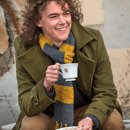You’ve most likely never considered this before, but believe me when I say it’s terribly important. People tuck things behind their ears for a variety of reasons; sometimes it’s simple practicality, sometimes it’s a halfhearted attempt to look intelligent, and sometimes it’s a genuine fashion statement. More than anything, though, it’s often done incorrectly.
That’s where I come in.
‘Will, what makes you think you’re qualified to do this?’ you might ask. Well, to my knowledge, no one else has done it, so there’s no one out there to dispute my claims. If you disagree with anything I say, I’m going to need some peer-reviewed evidence first.
Without further ado, below is a categorically organized instruction manual on how to ‘wear’ utensils behind your ear without looking like a tool or a cretin.
The Pencil
The pencil is the most common utensil to tuck behind your ear. It’s especially convenient in fields such as woodworking and contracting, when manual labor is combined with marking or writing. In this section, I am only referring to wooden pencil– carpentry pencils, classic old-school pencils, sketching pencils, etc.
The rule for pencils is simple: tip points in. No questions asked.
You’ll hear people say that the tip should point out because it’s more convenient to grab.
They are wrong. Don’t be one of those people.
The tip must point in because it slides into place easier, and looks indisputably better in all situations.
Pencils are one of the easiest looks to pull off, you can do it with basically any outfit. Work boots, jeans and a white t-shirt pairs well with a thick red carpentry pencil, and a Ticonderoga is as versatile as a pair of black Converse.
The Pen
Pens are the Canis familiaris of the writing utensil world. As Great Danes vary from Chihuahuas, so $3,000 golden fountain pens vary from Bic ballpoints. This makes writing concrete rules for when to tuck them behind your ear difficult.
In with my definition of a pen, I am also lumping in mechanical pencils, as they are more similar in structure and appearance to pens than to pencils.
In general, heavy pens with attached clips should be worn in a front pocket, or carried separately. This includes all fountain pens, and anything as heavy or heavier than the visionary Pilot G2.
Lighter pens and capped pens such as the omnipresent Bic ballpoint, and some cheaper brands of mechanical pencils can be worn behind the ear. As with pencils, the tip should point in, but there is more nuance with ink, as it can leave unpleasant markings on the side of the head.
Pens aren’t easy to pull off behind the ear. Situations like a trip to the cafeteria wearing business casual are acceptable, but it’ll never look as tasteful as the wooden pencil.
The Paintbrush
Paintbrushes are by far the sexiest thing to wear behind your ear.
Picture yourself, hair tousled by a gentle breeze, barefoot in the park as the sinking sun toys with light on the darkening landscape, with paint stained hands and an oil brush behind one ear.
It’s enough to make the soul sing.
Obviously, the brush needs to be facing out. No one wants oil paint in their hair.
Paintbrushes are versatile when it comes to pairing them with outfits; they’ll look just as good with a cocktail dress or slacks as jeans.
Where folks often run into trouble is matching their temperment with the look. Paintbrushes need to be worn with confidence. With pencils and pens, you can get away with a little lack of self-esteem, but with paintbrushes, you need to feel it.
The Chalkstick
If you don’t mind a little powder in your hair, a stick of chalk can look absolutely smashing. They pair well with tweed jackets and wingtips.
The Marker
Just don’t.
A note on other utensils: In my life, I’ve seen a total of one person do this, and it shook me to my very core. I saw a woman wearing a fork tucked behind her ear. This is some cutting edge stuff, and I wouldn’t recommend it unless you are some kind of trend influencer or have a Napoleon complex.



